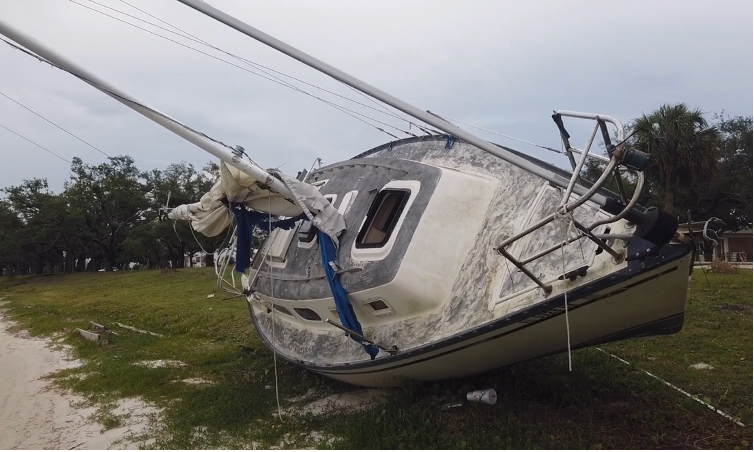
A storm impacted sailboat rests along the shoreline of Carl Gray Park near Gulf Coast State College. This vessel was removed after Panama City Law Enforcement Officers submitted the case for judicial processing. Vessels like this one, once legally processed, can be removed with the Hurricane Michael Marine Debris Removal Funds or by utilizing private funding sources. Photo by L. Scott Jackson
By L. Scott Jackson and Brittany Stark | UF/IFAS Extension Bay County and Florida Sea Grant
I received a phone call requesting an interview from a California based news outlet the day before Hurricane Michael made landfall October 10, 2018. The phone call came as I put the final hurricane shutter on my own home. I had spent the day preparing, bagging sand for old friends and new ones, I met at the sand pile in Lynn Haven. The day’s experience began to sink in – everyone is preparing for a major hurricane! The interviewer asked, “What concerns you the most about this storm?” I thought for second, “What concerns me the most, the Gulf of Mexico hasn’t seen a cold front this year. This is as hot as the Gulf can get, which can fuel large hurricanes.” I couldn’t have imagined what would happen in the next 24 hours after I spoke those words, despite how ominous they were.
In many ways, Michael was our version of the “Perfect Storm”. In the subsequent months and now years, Michael’s extensive devastation continues to confound residents and those responding to provide help.
Emergency responders with the Coast Guard and Florida Fish and Wildlife with Emergency Support Function 10 (ESF-10) worked effectively to address high priority vessels and marine debris problems immediately after Hurricane Michael. According to a media release January 11, 2019, “ESF-10 response teams have completed the following in their efforts to reduce the potential impact to Florida’s marine environment: Assessed 1,370 displaced, wrecked, sunken or beached vessels – 175 vessels mitigated and/or removed from the environment.”
I have been working with a team of professionals from the University of Florida, Florida Fish and Wildlife Commission, and local county Boards of County Commissioners in Bay, Gulf, and Franklin Counties to acquire funds and setup to clean-up what remains of the Hurricane related debris. The targeted area includes the shorelines of St Andrew, St Joe, and Apalachicola Bays. The team received notification of a 3 million dollar grant award from National Oceanic and Atmospheric Administration (NOAA) and the National Fish and Wildlife Foundation (NFWF) in April of 2020. This grant is designed specifically to help communities like ours recover and restore their bays and waterways after hurricanes.
Our project team made extensive use of Aerial Imagery. We estimate about 700 – 800 remaining marine debris targets including 90 vessels in the three-county project area, with the vast majority in Bay County and St Andrew Bay. Our goal is to clean-up and remove over 1,000 tons of marine debris during the project while protecting resources like seagrasses and shoreline vegetation.
The first phase of the vessel removal project was scheduled to begin in 2020. As a result of the pandemic and executive orders from Florida’s Governor, there was a pause to allow vessel owners the opportunity to address violations in this unprecedented situation. This put legal proceedings and investigations on hold from March through September 2020.
As 2021 began we had completed the remaining steps needed to initiate the clean-up and removal activities identified in our grant proposal. FWC completed legal investigations. NOAA finalized the required environmental assessment in consultation with appropriate federal and state agencies. Marine contractors and professionals were qualified and selected. We also employed two dedicated staff to work with impacted property owners that need assistance with shoreline debris and storm impacted vessels in Bay, Gulf, and Franklin Counties.
Our project Manager is Frank Mancinelli, a long-time Callaway resident and Air Force veteran, with professional experience and training in project management. Frank has a communications degree from Florida State University and a Master of Aeronautical Science / Safety degree from Embry-Riddle Aeronautical University. Our program Assistant is Bree Stark, a Florida native and long-time panhandle resident, who graduated from the University of Florida with a degree in Agricultural Education and Communication.
The number of remaining vessels and marine debris targets are astounding for everyone involved. Especially if it’s your property that is impacted. Each vessel has its own set of challenges that need to be addressed legally and logistically prior to removal. There are many obstacles that our project team can help property owners address.
The Hurricane Michael Debris Removal Team Wants to Hear from You!
Need a Hurricane Michael-impacted vessel removed? The Hurricane Michael Marine Debris Removal Project team wants to help!
If you would like to report a Hurricane Michael vessel in need of removal, contact Bree Stark by calling 850-378-2330 or by emailing bay@ifas.ufl.edu. Even if the vessel isn’t yours or on your property, the team needs your help to verify and expand their database of known sites for clean-up. You can also report Hurricane Michael impacted vessels via our online survey at http://bit.ly/HMVessel
(Portions of this Article Originally Published in the Panama City News Herald)
An Equal Opportunity Institution. UF/IFAS Extension, University of Florida, Institute of Food and Agricultural Sciences, Thomas Obreza, Interim-Dean for UF/IFAS Extension. Single copies of UF/IFAS Extension publications (excluding 4-H and youth publications) are available free to Florida residents from county UF/IFAS Extension offices.
- Stem to Stern (Northwest Florida November 2, 2023) - March 28, 2024
- Gearing up for Red Snapper - July 21, 2023
- ¡Conviértase un cuidador de las vieiras (“Scallop Sitter”)! - October 7, 2022
